Hello everyone, I have a question that has been bothering me. I am of Finnish descent , and I have noticed that besides the sword produced by Albion, there is absolutely no mention of swords of Finnish origin, although I am aware of Leuku and Puukko knives. So my question is: If the Finnish did use swords (if at all) what type of swords would have they used? Would they have used Viking swords or the later produced Norman designs? Did they use something else perhaps like something from German origins?
Hi Tim,
Oakeshott references a number of Finnish swords (or possibly a few Finnish swords a number of times) in "Records". It seems Viking styles are fairly well represented in Finland. A number of the medieval swords bearing inscriptions are also compared to certain Finnish (late Viking?) swords. I don't have time to look the relevant passages up, but Records is a good place to start.
Oakeshott references a number of Finnish swords (or possibly a few Finnish swords a number of times) in "Records". It seems Viking styles are fairly well represented in Finland. A number of the medieval swords bearing inscriptions are also compared to certain Finnish (late Viking?) swords. I don't have time to look the relevant passages up, but Records is a good place to start.
Yes, there are famous finnish viking swords found by dr. Leppaaho, Suontaka sword (Albion Valkirya) and some others. These swords found by Leppaaho were various types, some with faceted wheel pommels, gaddhjalt crossguards, some more typical looking viking swords... Many of them were specific for similar inscriptions on their blades...
Edited because of the wrong "Leppaaho" spelling.
Edited because of the wrong "Leppaaho" spelling.
Last edited by Luka Borscak on Sun 08 Jun, 2008 2:51 am; edited 1 time in total
| Tim M. wrote: |
| ...So my question is: If the Finnish did use swords (if at all) what type of swords would have they used? |
Hi Tim...
Ian Peirce's "Swords of the Viking Age" has several sword finds provenanced to Finland preserved in the Suomen kansallismuse, Helsinki Finland
I have attached images below with several other sword finds from Finaland.
(Basic data set in file name, just place cursor over image to see file name.)
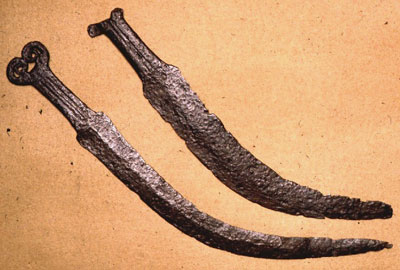
Akinakes c. 300 B.C.
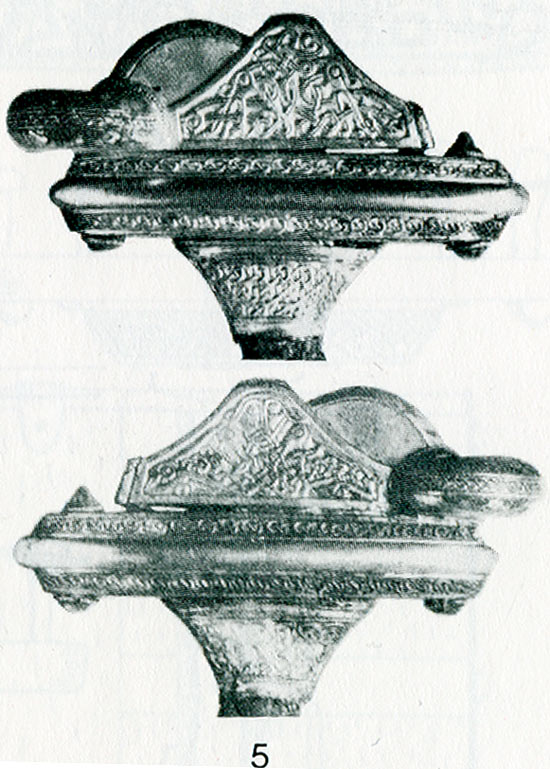
Find Place: Pappilanmaki Finland Photo from "Das Schwert im Fruhen Mittelalter" by Wilfried menghin
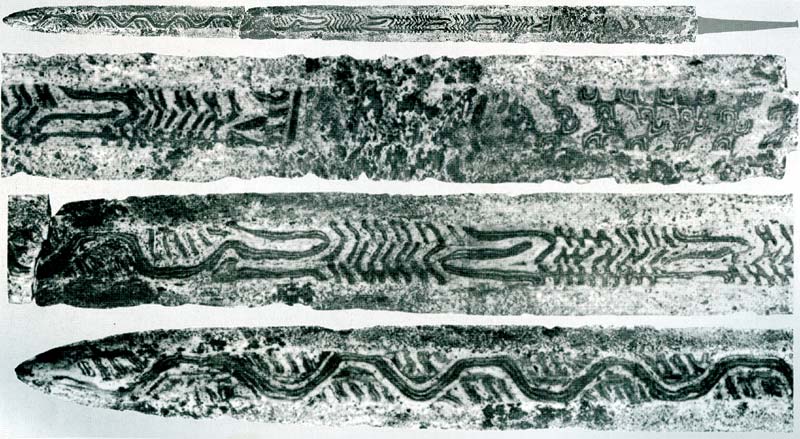
Find place: Vehmaa Lahdinko Huolila Finland 8th century. From National Museum of Finland Photo from "Swords of the Viking Age" by Ian Peirce
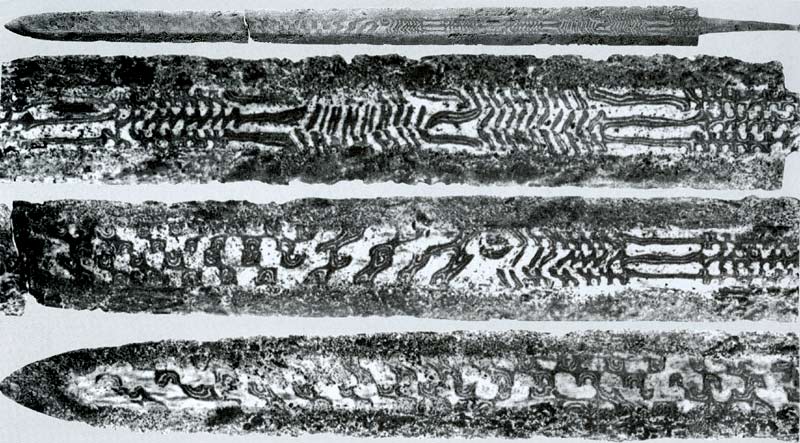
Find place: Vehmaa Lahdinko Huolila Finland 8th century. From National Museum of Finland Photo from "Swords of the Viking Age" by Ian Peirce
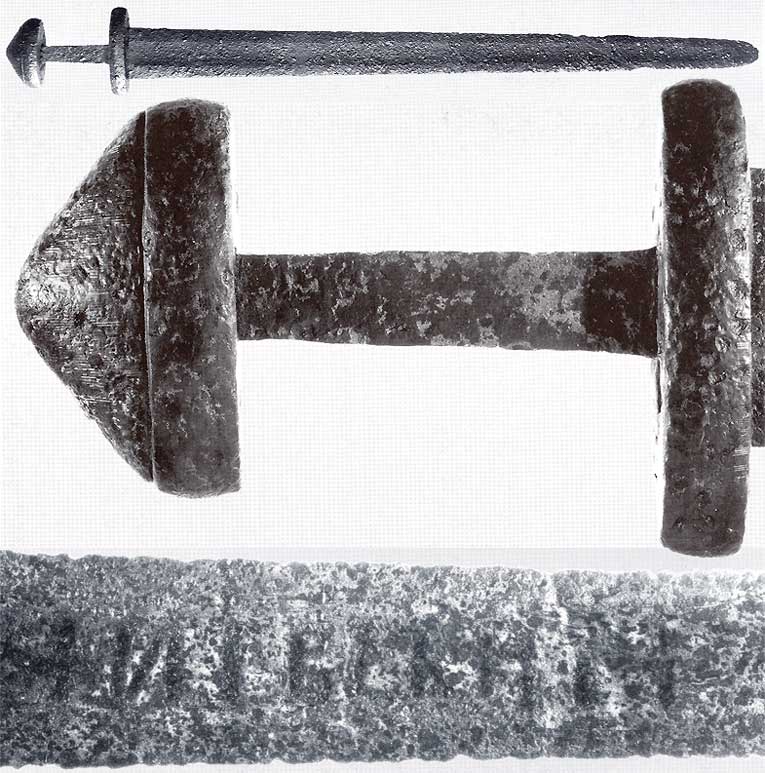
Find Place: Peltorinne Finland 9th century from Suomen kansallismuse, Helsinki Finland . Photo from "Swords of the Viking Age" by Ian Peirce

Find Place: Leikkimaki Finland 11th century from Suomen kansallismuse, Helsinki Finland . Photo from "Swords of the Viking Age" by Ian Peirce

Find Place: Vesilahti Finland 11th century from Suomen kansallismuse, Helsinki Finland . Photo from "Swords of the Viking Age" by Ian Peirce
Find Place: Kangasala Finland 10th century from Suomen kansallismuse, Helsinki Finland . Photo from "Swords of the Viking Age" by Ian Peirce [ Download ]
Here are a few more...
Hope it helps
take care
ks
 Attachment: 99.94 KB
Attachment: 99.94 KB
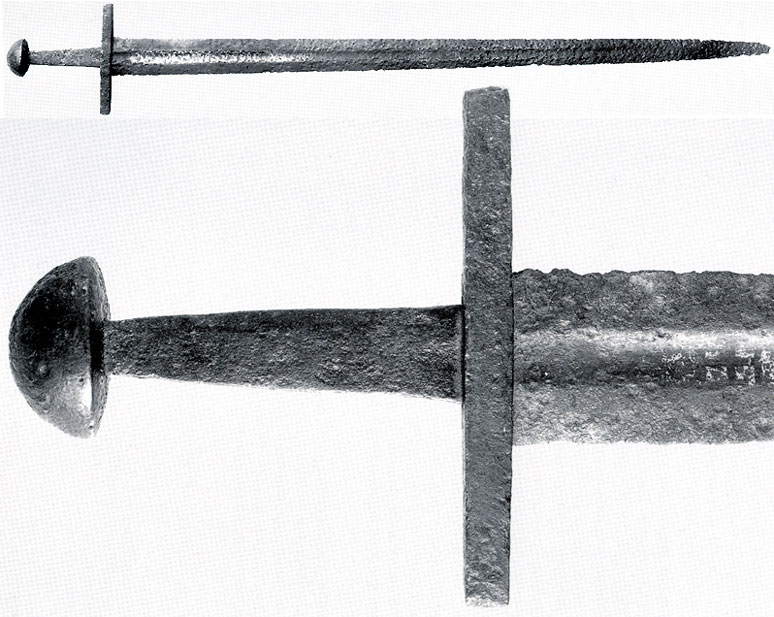
Find Place: Vammala Finland 11th century from Suomen kansallismuse, Helsinki Finland . Photo from "Swords of the Viking Age" by Ian Peirce
 Attachment: 91.58 KB
Attachment: 91.58 KB
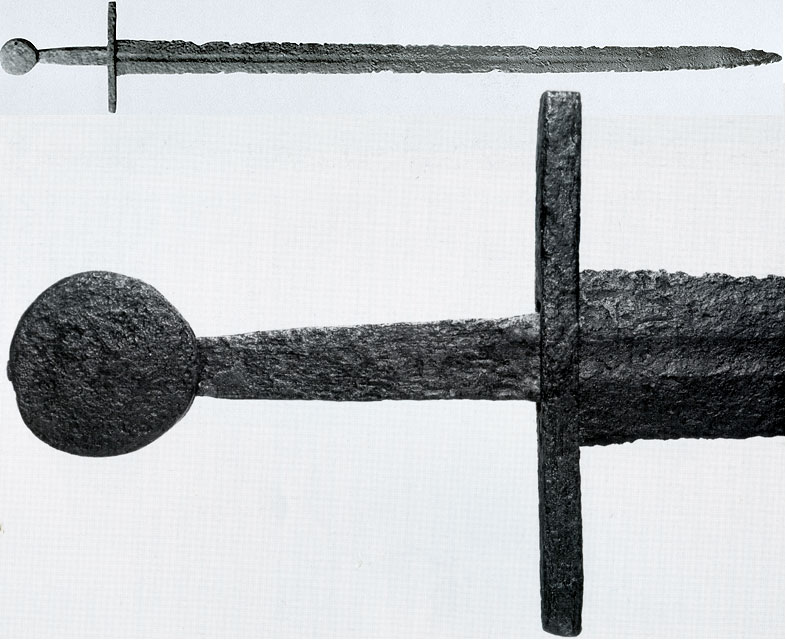
Find Place: Jamsa Finland 11th century from Suomen kansallismuse, Helsinki Finland . Photo from "Swords of the Viking Age" by Ian Peirce
 Attachment: 71.42 KB
Attachment: 71.42 KB
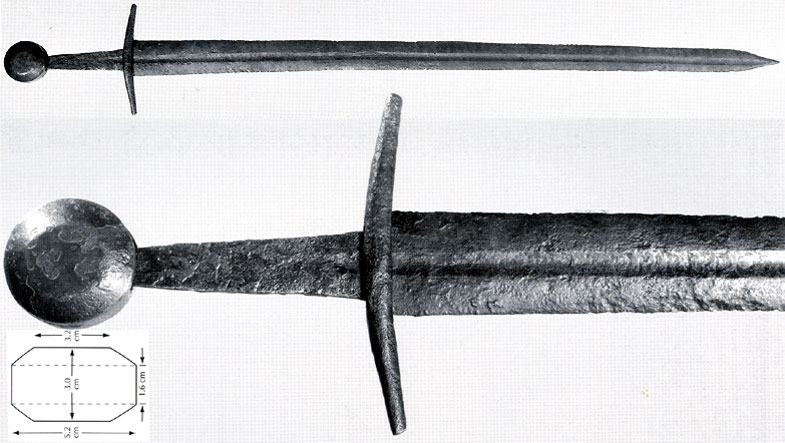
Find Place: Marikkovaara Finland 12th century from Suomen kansallismuse, Helsinki Finland . Photo from "Swords of the Viking Age" by Ian Peirce
 Attachment: 99.24 KB
Attachment: 99.24 KB
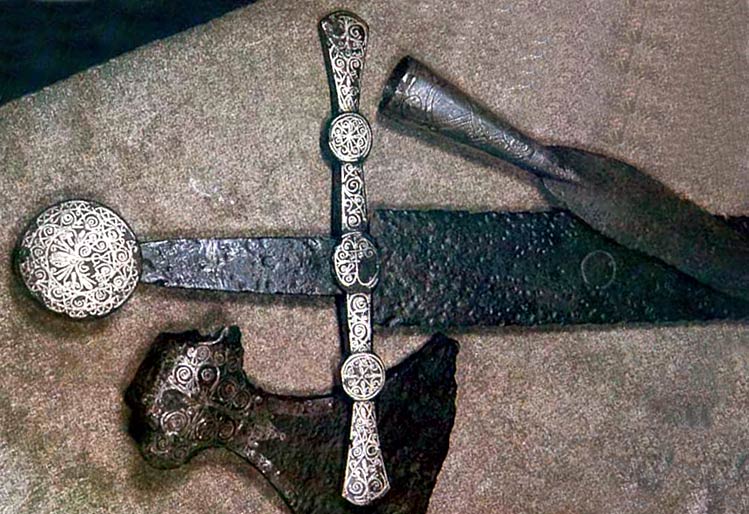
Find Place: Satakunta Eura Pappilanmäki Finland. from Suomen kansallismuse, Helsinki Finland
 Attachment: 98.6 KB
Attachment: 98.6 KB
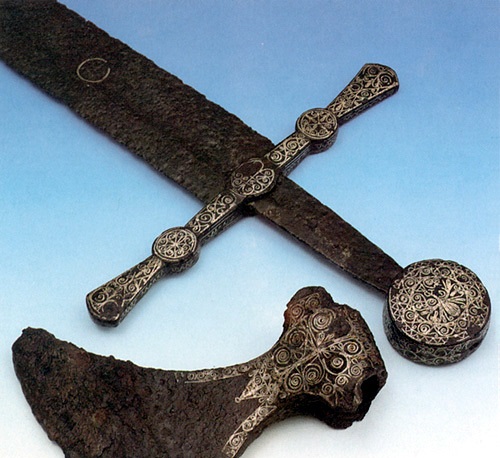
Find Place: Satakunta Eura Pappilanmäki Finland. from Suomen kansallismuse, Helsinki Finland
Hope it helps
take care
ks

Find Place: Vammala Finland 11th century from Suomen kansallismuse, Helsinki Finland . Photo from "Swords of the Viking Age" by Ian Peirce

Find Place: Jamsa Finland 11th century from Suomen kansallismuse, Helsinki Finland . Photo from "Swords of the Viking Age" by Ian Peirce

Find Place: Marikkovaara Finland 12th century from Suomen kansallismuse, Helsinki Finland . Photo from "Swords of the Viking Age" by Ian Peirce

Find Place: Satakunta Eura Pappilanmäki Finland. from Suomen kansallismuse, Helsinki Finland

Find Place: Satakunta Eura Pappilanmäki Finland. from Suomen kansallismuse, Helsinki Finland
Tim,
There is not, as far as I'm aware, a specifically Finnish sword style. Given our common history with both Sweden and Russia the sword styles reflected the common style of a given period. It is assumed that the blades were often imported from the continental Europe and at least some of the grips were produced locally according to the local taste.
It may be worth mentioning that a great part of the discovered swords are highly decorated pieces of great value. I think that that is evident from the images in the previous posts. That can mean that a sword was a sign of high position. But it can also mean that any wealth was blown away into showing off with an expensive sword...
Leuku, by the way, is more specifically a Sami, or Lapp people's tradition. In Finland both puukko and leuku are considered more tools than weapons.
-Pete
There is not, as far as I'm aware, a specifically Finnish sword style. Given our common history with both Sweden and Russia the sword styles reflected the common style of a given period. It is assumed that the blades were often imported from the continental Europe and at least some of the grips were produced locally according to the local taste.
It may be worth mentioning that a great part of the discovered swords are highly decorated pieces of great value. I think that that is evident from the images in the previous posts. That can mean that a sword was a sign of high position. But it can also mean that any wealth was blown away into showing off with an expensive sword...
Leuku, by the way, is more specifically a Sami, or Lapp people's tradition. In Finland both puukko and leuku are considered more tools than weapons.
-Pete
Thank you all for the information and especially for the pictures that will help give me an idea what to look for.
Thanks Kirk! Some of those are new to me and especially the pics of those pattern welded blades are just awesome. They look like someone tried to show the whole arsenal of skill to produce different kinds of patterns. Cool!
| Risto Rautiainen wrote: |
| ...Some of those are new to me and especially the pics of those pattern welded blades are just awesome. They look like someone tried to show the whole arsenal of skill to produce different kinds of patterns. Cool! |
Hey Risto...
Actually it is "blade" not "blades." Those are pictures of the different sides of the same blade! :eek:
I agree with you... The genius of craftsmanship in this blade is probably the best extant example of variety of forms in a pattern welded sword find. If my interpretation is right, it not only shows genius by also real determination on the part of the smith.
As best I understand it's construction from the images, it appears that the core on each side of the blade is made up of five billets (or bars). Thats 10 billets total. And that's not counting the other 2 used for the edges. In the upper section (strong part) of the blade, there are three billets alternating twisted and untwisted (straight) in line across the blade. In the lower part or (weak section) of the blade the core is made of two billets on each side twisted on their whole length with no straight or untwisted sections.
In the side shown in the lower picture, the radically different twisted pattern in the upper 3 billet and lower 2 billet sections suggests to me that these were built separately and then welded together in the middle. You will also notice in the lower section, as the pattern nears the tip, the twists go from diagonals to circles then back to diagonals angled in the other direction. My guess is that this is a feature of grinding the fuller. The deeper you grind into the twisted billet the more circles you see as you grind through the center to the other side it becomes more linear but in the opposite direction.
In the side shown in the upper picture, rather than building a 3 billet top and 2 billet bottom welding them together in the middle, it looks as though this Finnish genius built this whole side of the core out of three long billets. In the upper middle section you will notice there are alternating twisted and untwisted sections in line (as on the other side). However, in the middle (this it the genius part) the center billet is pulled up and the two side billets (which are now completely twisted) are welded together and then the middle billet, that was pulled up, is hammer welded as an inlay, back and forth like a snake, across the two-billet lower core! During this process something happened to the very top (strong) part of this side of the core and it was cut out and another three billet section was welded to it as a patch and then ground deeply. Then these two five billet sides of the core were welded together and then the edges were welded on.
So... .you can see, this is a fantastic example of what a determined Finn can do with a little iron and fire :D
take care
ks
Are these swords considered of Finnish origin or were they left/lost there by traders? It seems when I have read about a sword found in Finland they were always supposed to be of Viking origin. Well for the Viking Age ones of course.
| Jim Adelsen wrote: |
| Are these swords considered of Finnish origin or were they left/lost there by traders? It seems when I have read about a sword found in Finland they were always supposed to be of Viking origin...
|
Hi Jim...
That's a very interesting question. It seems that it is fashionable to consider that smith in the territories that produced "vikings" (pirates). Bought the nice pattern-welded blades from other smiths further south and hilted the blades themselves, then carried them on their adventures into other areas leaving them there for others to find and infer they were made by local smiths. This is a very interesting inference and may be true. However, here are some things to keep in mind:
1. It is a story. When we consider just the hard evidence we find that Suomen kansallismuse in Helsinki Finland has recorded that these swords were found in the ground in the territory that is today called Finnland.
2. Only two or three persons could make a patternwelded blade working together. Only one of these would need the knowledge of making a pattern-welded blade.
3. It is very possilbe that Vikings did not use special "viking swords". They just used swords that were popular at that time.
4. It is very likely that the sword finds we see in publications and on display in the museums are only a fraction of the swords that have been discovered and now reside in private collections and museum depots. And these are only a fraction of sword finds that have washed out along lakes and rivers and have been destroyed by the elements. And all of these are only a small fraction of sword finds that remained buried and have not yet been discovered. And these are only a small fraction of the swords that were manufactured and were not preserved or were reused. All this to say that there were probably many more swords around than what we see preserved and on display today.
Considering these things it is also possilbe that either a smith from Finnland had learned the skills needed to produce these swords, either by traveling or coming into contact with a smith that traveled into the area and produced many swords that have not been preserved or discovered and these swords were based on common functional designs of the time, the same funtional designs that vikings also used. And since we are telling stories, it is possible that this Finnish smith exported these swords to vikings across the way and they carried them into distant lands.
ks
one of the other swords has an engraved handle. does anyone know the material?
| Audun Refsahl wrote: |
| one of the other swords has an engraved handle. does anyone know the material? |
Hey Audun...
If it is the Leikkimaki Finnland sword you are referring, then Pierce relates that it is silver plated with gold wire inlay. I assume that the base is iron. You can see in the attachment that the iron base was scored and then silver was burnished into the grooves. As the silver wears away in places you can see the grooving underneath.
The Christian inscriptions in the blade would put it in the 11th century. Pierce believes it may be a cerimonial sword because of the decoration and the fact that its Cog is 28.4 cm beyond the guard. Lots more info in Ian Peirce's "Swords of the Viking Age." If anyone is interested in swords of this time, this work is a must.
take care
ks

Detail of image from "Swords of the Viking Age" by Ian Peirce

Find Place: Leikkimaki Finland 11th century
Preserved in Suomen kansallismuse, Helsinki Finland . Photo from "Swords of the Viking Age" by Ian Peirce
| Kirk Lee Spencer wrote: |
|
3. It is very possilbe that Vikings did not use special "viking swords". They just used swords that were popular at that time. |
Kirk,
As much a my national pride wants me to believe that the Finnish smiths produced and even exported Viking age blades I am leaning towards what is quoted above. Actually many of the blades and also hilts are presumably made by Frankish smiths. For example a couple of dozen blades with ULFBRETH inscription.
-Pete
Hey Pete...
I agree... the most popular view is that smiths set up shop near the source of iron in the south and manufactured blades and exported them north where they were hilted. And that is probably true. (I wonder if anybody knows if this line of thinking is from textural evidence or is it based on distribution studies?)
Yet even if this is true as a general rule... there may have been exceptions and probably were. Exceptions like the migration of swordsmiths or smithing knowledge to the north.
Nor does it rule out mankind's ability of reverse engineering. No one supposes that all iron objects were imported. So certainly there were local smiths. After spending many years hammering iron into utensils, if a smith got a good look at a nice pattern-welded sword blade, I suspect that they might want to give it a go. And certainly, eventually, a local smith might master it an add sword blades to their repertoire, or maybe even change their profession.
ks
I agree... the most popular view is that smiths set up shop near the source of iron in the south and manufactured blades and exported them north where they were hilted. And that is probably true. (I wonder if anybody knows if this line of thinking is from textural evidence or is it based on distribution studies?)
Yet even if this is true as a general rule... there may have been exceptions and probably were. Exceptions like the migration of swordsmiths or smithing knowledge to the north.
Nor does it rule out mankind's ability of reverse engineering. No one supposes that all iron objects were imported. So certainly there were local smiths. After spending many years hammering iron into utensils, if a smith got a good look at a nice pattern-welded sword blade, I suspect that they might want to give it a go. And certainly, eventually, a local smith might master it an add sword blades to their repertoire, or maybe even change their profession.
ks
Sorry to resurrect this old thread. Over 300 viking age swords have been found in Finland. And a large number of swords from other eras too starting from the Bronze age.
Most sword blades were imported because there wasn't a large market for swordsmiths. Spears, javelins, axes, knives and arrows were the weapons of choise. A particular locally produced unique type of angon javelin was perhaps the iconic Finnic weapon during the Iron age.
Here's an interesting link on Iron age swords in Finland (it's all in Finnish though..)
http://www.helsinki.fi/arkeologia/rautaesine/...miekat.htm
Could this sword be the same that the Windlass Damascus Viking Sword is based on?
The Windlass replica is of the same type (Petersen Z) and there are around 20 of this particular type of sword found from Finland. But the Windlass description says it's from 850-900 AD which doesn't match with this piece...
Could anyone who owns the Records Of The Medieval Sword (by Ewart Oakeshot) check page 83 for me and tell me if it's the same sword as M2886:11 Petersen type Z pictured here on this thread?
[/i]
Most sword blades were imported because there wasn't a large market for swordsmiths. Spears, javelins, axes, knives and arrows were the weapons of choise. A particular locally produced unique type of angon javelin was perhaps the iconic Finnic weapon during the Iron age.
Here's an interesting link on Iron age swords in Finland (it's all in Finnish though..)
http://www.helsinki.fi/arkeologia/rautaesine/...miekat.htm
| Kirk Lee Spencer wrote: |
| Find Place: Vesilahti Finland 11th century from Suomen kansallismuse, Helsinki Finland . Photo from "Swords of the Viking Age" by Ian Peirce |
Could this sword be the same that the Windlass Damascus Viking Sword is based on?
The Windlass replica is of the same type (Petersen Z) and there are around 20 of this particular type of sword found from Finland. But the Windlass description says it's from 850-900 AD which doesn't match with this piece...
Could anyone who owns the Records Of The Medieval Sword (by Ewart Oakeshot) check page 83 for me and tell me if it's the same sword as M2886:11 Petersen type Z pictured here on this thread?
[/i]
On page 83 there is a drawing labled iv that seems a good match for the blade that you are talking about.
It is interesting that Finland has "produced" the heaviest single-hand sword I know of up to date - it was discovered in iron age grave in Eura and weights 2.7 kg . Also, National History Museum in Helsinki has a very nice collection of swords typically associated with Vendel period as well as shield bosses charactereistic to this time.
Page 1 of 1
You cannot post new topics in this forumYou cannot reply to topics in this forum
You cannot edit your posts in this forum
You cannot delete your posts in this forum
You cannot vote in polls in this forum
You cannot attach files in this forum
You can download files in this forum
All contents © Copyright 2003-2006 myArmoury.com — All rights reserved
Discussion forums powered by phpBB © The phpBB Group
Switch to the Full-featured Version of the forum
Discussion forums powered by phpBB © The phpBB Group
Switch to the Full-featured Version of the forum